Immunogenicity and Cross-Reactivity of Rhesus Adenoviral Vectors
- PMID: 29563285
- PMCID: PMC5952169
- DOI: 10.1128/JVI.00159-18
Immunogenicity and Cross-Reactivity of Rhesus Adenoviral Vectors
Abstract
Adenovirus (Ad) vectors are being investigated as vaccine candidates, but baseline antivector immunity exists in human populations to both human Ad (HuAd) and chimpanzee Ad (ChAd) vectors. In this study, we investigated the immunogenicity and cross-reactivity of a panel of recently described rhesus adenoviral (RhAd) vectors. RhAd vectors elicited T cells with low exhaustion markers and robust anamnestic potential. Moreover, RhAd vector immunogenicity was unaffected by high levels of preexisting anti-HuAd immunity. Both HuAd/RhAd and RhAd/RhAd prime-boost vaccine regimens were highly immunogenic, despite a degree of cross-reactive neutralizing antibodies (NAbs) between phylogenetically related RhAd vectors. We observed extensive vector-specific cross-reactive CD4 T cell responses and more limited CD8 T cell responses between RhAd and HuAd vectors, but the impact of vector-specific cellular responses was far less than that of vector-specific NAbs. These data suggest the potential utility of RhAd vectors and define novel heterologous prime-boost strategies for vaccine development.IMPORTANCE To date, most adenoviral vectors developed for vaccination have been HuAds from species B, C, D, and E, and human populations display moderate to high levels of preexisting immunity. There is a clinical need for new adenoviral vectors that are not hindered by preexisting immunity. Moreover, the development of RhAd vector vaccines expands our ability to vaccinate against multiple pathogens in a population that may have received other HuAd or ChAd vectors. We evaluated the immunogenicity and cross-reactivity of RhAd vectors, which belong to the poorly described adenovirus species G. These vectors induced robust cellular and humoral immune responses and were not hampered by preexisting anti-HuAd vector immunity. Such properties make RhAd vectors attractive as potential vaccine vectors.
Keywords: HIV; adenovirus; rhesus; simian immunodeficiency virus; vector.
Copyright © 2018 Iampietro et al.
Figures
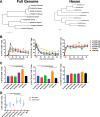

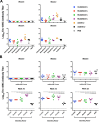
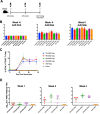
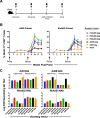

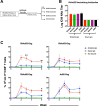
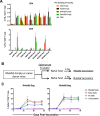
Similar articles
-
Humoral and cellular immune response to a single dose of a novel bivalent recombinant adenovirus-vector vaccine against West Nile virus and chikungunya virus in mice.Virol J. 2025 Jul 25;22(1):256. doi: 10.1186/s12985-025-02878-5. Virol J. 2025. PMID: 40713773 Free PMC article.
-
Characterization and comparison of immunity against MPXV for individuals infected with MPXV or vaccinated with modified vaccinia Ankara vaccines.J Immunol. 2025 Feb 1;214(2):211-222. doi: 10.1093/jimmun/vkae031. J Immunol. 2025. PMID: 40073241
-
Immunogenicity and seroefficacy of pneumococcal conjugate vaccines: a systematic review and network meta-analysis.Health Technol Assess. 2024 Jul;28(34):1-109. doi: 10.3310/YWHA3079. Health Technol Assess. 2024. PMID: 39046101 Free PMC article.
-
Rapid Cloning of Novel Rhesus Adenoviral Vaccine Vectors.J Virol. 2018 Feb 26;92(6):e01924-17. doi: 10.1128/JVI.01924-17. Print 2018 Mar 15. J Virol. 2018. PMID: 29298888 Free PMC article.
-
Systemic pharmacological treatments for chronic plaque psoriasis: a network meta-analysis.Cochrane Database Syst Rev. 2021 Apr 19;4(4):CD011535. doi: 10.1002/14651858.CD011535.pub4. Cochrane Database Syst Rev. 2021. Update in: Cochrane Database Syst Rev. 2022 May 23;5:CD011535. doi: 10.1002/14651858.CD011535.pub5. PMID: 33871055 Free PMC article. Updated.
Cited by
-
Therapeutic cancer vaccines for pediatric malignancies: advances, challenges, and emerging technologies.Neurooncol Adv. 2021 Feb 11;3(1):vdab027. doi: 10.1093/noajnl/vdab027. eCollection 2021 Jan-Dec. Neurooncol Adv. 2021. PMID: 33860227 Free PMC article. Review.
-
Role of Adenoviruses in Cancer Therapy.Front Oncol. 2022 Jun 9;12:772659. doi: 10.3389/fonc.2022.772659. eCollection 2022. Front Oncol. 2022. PMID: 35756634 Free PMC article. Review.
-
Novel approaches for vaccine development.Cell. 2021 Mar 18;184(6):1589-1603. doi: 10.1016/j.cell.2021.02.030. Cell. 2021. PMID: 33740454 Free PMC article. Review.
-
Serological insights from SARS-CoV-2 heterologous prime and boost responses in Thailand.Sci Rep. 2025 Jan 9;15(1):1519. doi: 10.1038/s41598-024-84392-2. Sci Rep. 2025. PMID: 39789037 Free PMC article.
-
A New Look at Vaccine Strategies Against PPRV Focused on Adenoviral Candidates.Front Vet Sci. 2021 Sep 8;8:729879. doi: 10.3389/fvets.2021.729879. eCollection 2021. Front Vet Sci. 2021. PMID: 34568477 Free PMC article. Review.
References
-
- Abbink P, Lemckert AAC, Ewald BA, Lynch DM, Denholtz M, Smits S, Holterman L, Damen I, Vogels R, Thorner AR, O'Brien KL, Carville A, Mansfield KG, Goudsmit J, Havenga MJE, Barouch DH. 2007. Comparative seroprevalence and immunogenicity of six rare serotype recombinant adenovirus vaccine vectors from subgroups B and D. J Virol 81:4654–4663. doi:10.1128/JVI.02696-06. - DOI - PMC - PubMed
-
- Dudareva M, Andrews L, Gilbert SC, Bejon P, Marsh K, Mwacharo J, Kai O, Nicosia A, Hill AVS. 2009. Prevalence of serum neutralizing antibodies against chimpanzee adenovirus 63 and human adenovirus 5 in Kenyan children, in the context of vaccine vector efficacy. Vaccine 27:3501–3504. doi:10.1016/j.vaccine.2009.03.080. - DOI - PubMed
Publication types
MeSH terms
Substances
Grants and funding
LinkOut - more resources
Full Text Sources
Other Literature Sources
Research Materials

